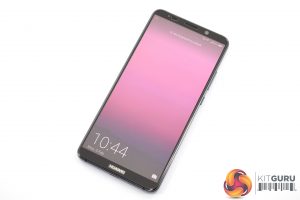Design
Note: if the above gallery is not displaying properly, please disable AdBlock as it is known to interfere with our display code.
Getting right to it, the Mate 10 Pro is undoubtedly a beautifully designed smartphone. It's slim bezels are immediately apparent, with just a small forehead and chin visible. For a phone with a 6-inch display, too, it is actually 4.2mm shorter than the iPhone 8 Plus – and that phone only has a 5.5-inch display. Full dimensions of the Mate 10 Pro are as follows: 154.2 x 74.5 x 7.9 mm.
Aside from the impressive screen-to-body ratio, the Mate 10 Pro is also very well constructed. It's front and back are made from Corning Gorilla Glass, while the glossy frame of the phone is made of aluminium. Some people don't like glass-backed phones as they can crack and are often fingerprint magnets, which is fair enough. However, I think the Mate 10 Pro looks excellent, and Gorilla Glass is actually more scratch-resistant than aluminium, so that is in its favour.
In terms of ports and connectivity, the USB-C port is situated on the bottom edge of the phone, next to the downward-firing speaker. Sadly there is no headphone jack on the Mate 10 Pro. A power button and volume rocker are placed on the right-hand edge of the phone, while the SIM-tray is positioned on the left-hand side. The Mate 10 Pro supports dual nano-SIMs, but there is no microSD slot to expand the storage past the internal 128GB of space. Lastly, the phone's forehead is home to the 8MP front-facing camera as well as the secondary speaker unit.
Turning to the back of the phone, we find a fingerprint scanner positioned directly below the dual-camera setup. These cameras have been developed in partnership with Leica, so our expectations are certainly high. Each lens sports a f/1.6 aperture, though the primary camera is a colour 12MP sensor and the secondary camera is a monochrome 20MP sensor.
But more on that later.
Display
The Mate 10 Pro's 6-inch display has several interesting aspects to it. Starting with resolution, Huawei opted for the 18:9 aspect ratio which is the new standard for modern smartphones. Because of that, the resolution has been dubbed ‘Full HD +', meaning 2160×1080. This may not be as sharp as other phones with 1440p screens, but at 402 PPI I think it is plenty sharp enough. The lower resolution – relatively speaking – could also help with battery life, but we'll come to that later in the review.
Most importantly, the Mate 10 Pro's screen uses an AMOLED panel and that gives it plenty of advantages over more traditional LCD displays. For one, it has a lovely contrast ratio, with some really deep and inky blacks which make watching videos a breathtaking experience. Colours are also very punchy and look really good, while there are again implications for battery life. The only slight downside that I've noticed so far is a small amount of colour shift as you tilt the screen – it is only minor, but it is noticeable especially when viewing apps with white backgrounds.
Elsewhere, the display has an excellent range of brightness which has been lovely to use. Not only does the screen get more than bright enough to use outside, it also gets very dim which makes using your phone at night easier on the eyes.
Lastly, Huawei provides a tool in the phone's software settings to adjust colour balance to your liking. Out of the box, I found the display to be slightly warm, but thanks to the provided colour wheel it is an easy fix. On the whole, it is a really lovely AMOLED panel.
 KitGuru KitGuru.net – Tech News | Hardware News | Hardware Reviews | IOS | Mobile | Gaming | Graphics Cards
KitGuru KitGuru.net – Tech News | Hardware News | Hardware Reviews | IOS | Mobile | Gaming | Graphics Cards














Pansharpening has been used on satellites for decades, good idea by Huawei to use such an overlooked photo technique to really make the camera stand out.